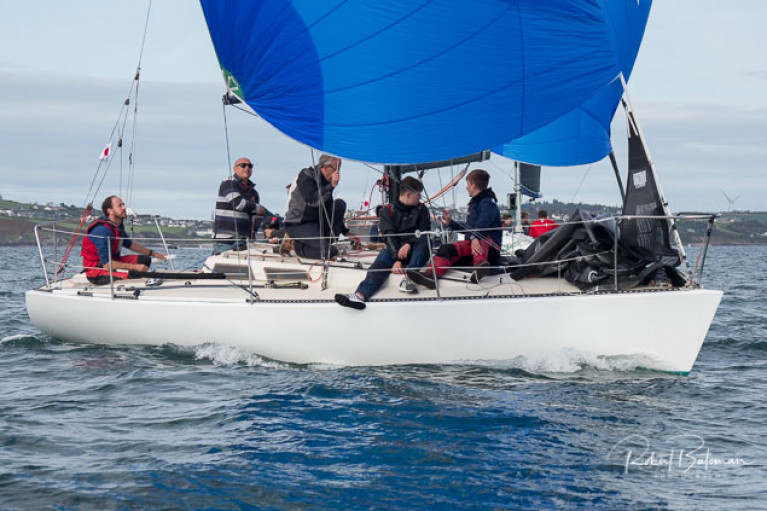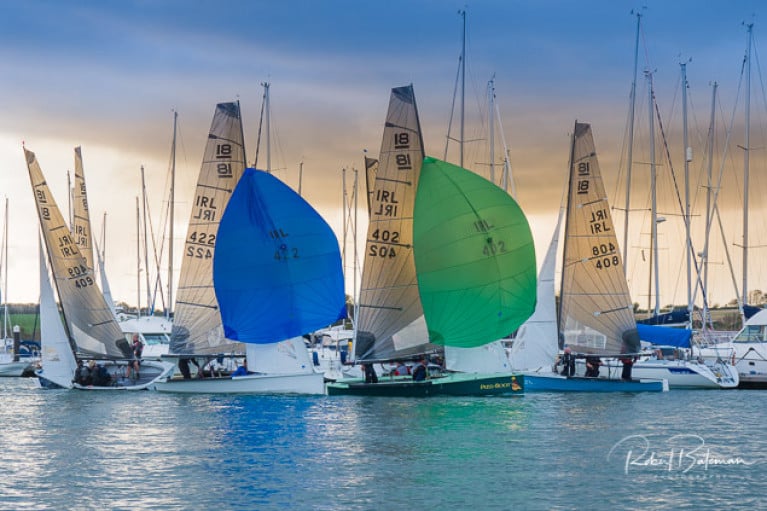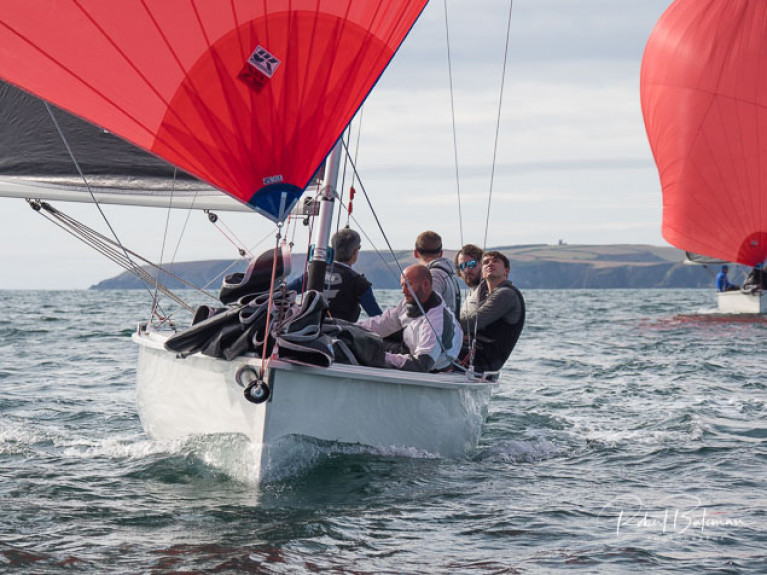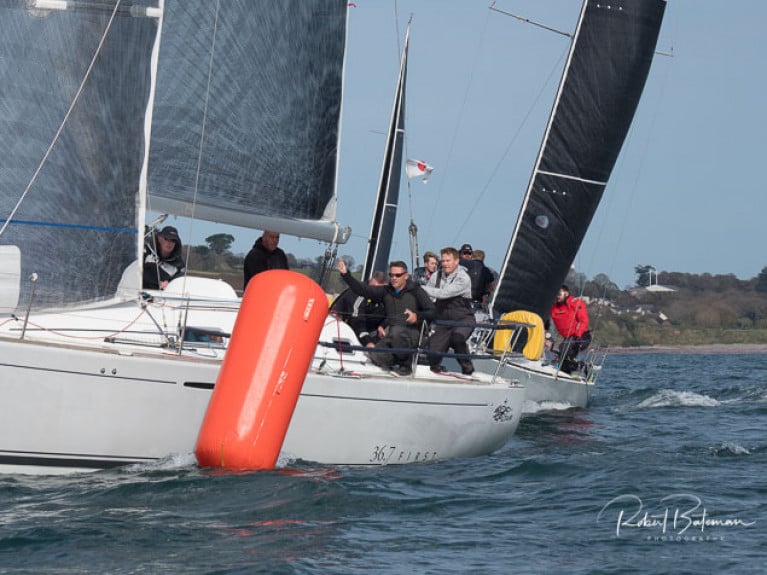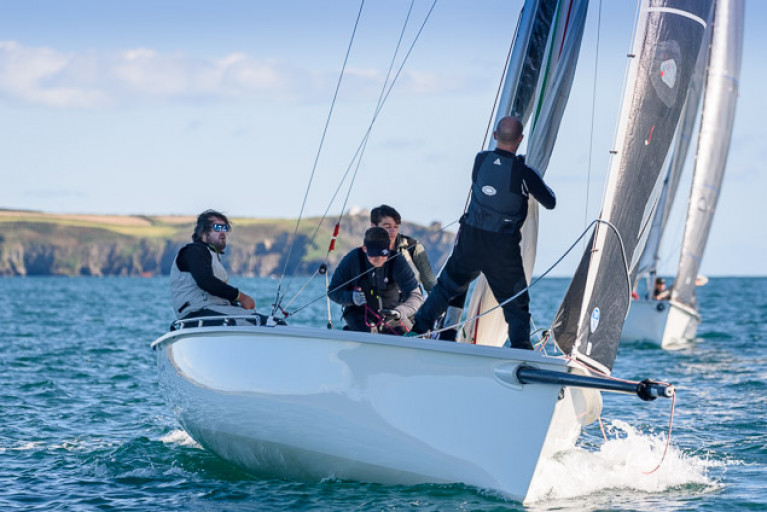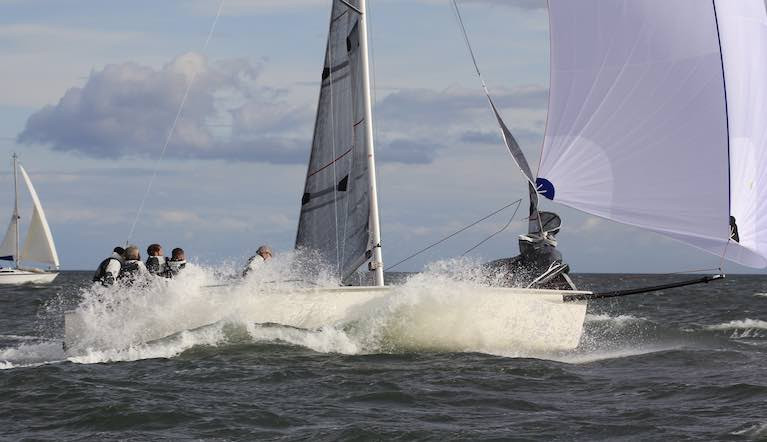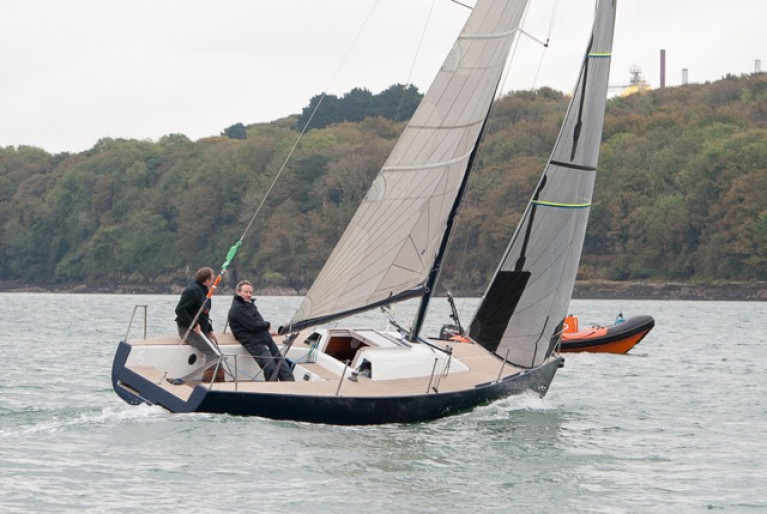Displaying items by tag: Cork Harbour
Royal Cork Abandons Autumn Racing Today Due to Gales (UPDATED)
Sunday 9 am: Racing today in Royal Cork's AIB Autumn Series in Cork Harbour has been abandoned. 'N' over 'A' was hoisted on the club flagpole this morning indicating the second day of the series has fallen to strong winds. As Afloat reported earlier (see below) the club waited until this morning before making the final call, "We wanted to give it every chance but the breeze now looks to be coming in at midday", said RCYC's Alex Barry.
Saturday: 6 pm Although the shadow of a gale warning hangs over the second day of racing in Sunday's AIB Autumn Series in Cork Harbour, the Royal Cork Yacht Club organisers say this evening they eye 'a window' of opportunity to race and won't make any call until tomorrow morning.
The 1720s that raced separately for Munster Championships honours last weekend will join the Series tomorrow and further boost the 50-boat fleet for week two. The sportsboat class will start with Class 0 but have a separate set of results.
Forecasts show north-westerly gusts up to 45 mph at start time tomorrow morning.
 The XC Weather forecast for Crosshaven
The XC Weather forecast for Crosshaven
Irish sailing's September Song Made Sweeter by its Brevity
Thank you, September. You did your best to provide us with good sailing as ingenious moves were implemented to run modified pandemic-compliant events which gave proper meaning to the season, and to our sailing traditions. It was neither your fault - nor ours - that in some places a situation beyond everyone's control caused a severe foreshortening of programmes carefully tailored to deal with circumstances which then seemed to change on a daily or even hourly basis.
For sure, some fortunate sailing centres managed to have limited sailing all month, scraping weekly sport out of the last of the daylight as the evenings rapidly closed in, and working the weekends with skill. But in other locations, the guillotine slammed down at mid-month, and people found that whatever good sailing they might have experienced now had to become recalibrated in the memory bank as highlights of their very truncated sailing year.
ROYAL CORK MAKES THE BEST OF IT
No club more thoroughly deserved a final full month of good fortune in September than the Royal Cork in Crosshaven, as they emerged battered but unbowed from what should have been their globally-focused Tricentenary. Most appropriately it was that renowned backbone-of-the-club, the National 18s, which saw September out with a flourish on its very last day, racing up and down the Owenabue River off the clubhouse on Wednesday evening as the twilight settled gently until this all-important month of September had only a matter of hours to run.
 Twilight for the Gods…..the National 18s at Royal Cork managed their last evening race – an in-river event off the clubhouse – on Wednesday, September 30th. The winner was Nick Walsh's Fifty Shades. Photo: Robert Bateman
Twilight for the Gods…..the National 18s at Royal Cork managed their last evening race – an in-river event off the clubhouse – on Wednesday, September 30th. The winner was Nick Walsh's Fifty Shades. Photo: Robert Bateman
With some more good luck, the club will be able to continue its Autumn League this weekend, but meanwhile like other sailing centres, Crosshaven and Cork Harbour found that September presented unusually meaningful opportunities to stage events which celebrated the places of sailing and its people, and in Cork Harbour, the come-all-ye event which best does this is Cove SC's annual Cobh to Blackrock Race.
Even though the Royal Cork had experienced its 2020 highlight in being the finish point for the successful pop-up Fastnet 450 Race in August, the Cobh-Blackrock Race is an ancient piece of the harbour's fabric, and September obligingly provided the conditions for a fast race and a real sense of occasion with life going on regardless.
 The Golden Oldie comes to town. The restored 1898 Cork Harbour One Design Jap, raced by Royal Cork Admiral Colin Morehead, reaches the finish of the Cobh-Blackrock Race. The CHODs are renowned for their pleasant steering characteristics - even on this gusty day, Jap's tiller is still in a very manageable fore-and-after position. Photo: Robert Bateman
The Golden Oldie comes to town. The restored 1898 Cork Harbour One Design Jap, raced by Royal Cork Admiral Colin Morehead, reaches the finish of the Cobh-Blackrock Race. The CHODs are renowned for their pleasant steering characteristics - even on this gusty day, Jap's tiller is still in a very manageable fore-and-after position. Photo: Robert Bateman
DUN LAOGHAIRE'S COMPACTED SEASON DEALT SUCCESSFULLY WITH REALITY
In Dun Laoghaire, Dun Laoghaire Motor Yacht Club's annual Kish Race is something that should in time be seen as a celebration of Dublin Bay, and in September 2020 is was shaping up that way as other events got the chop because of their inevitably high sociability quotient. Entries were flying up as racing round the Kish became more desirable than ever, but with a couple of days to go, the latest set of regulations wiped the race off the blackboard. That said, now that we know how much it can mean to the Dun Laoghaire sailing community, it's surely an all-comers cruiser-racer event which deserves more oomph in the future.
Meanwhile, as we write this there's still hope that some more racing will be squeezed out of Dun Laoghaire before the year is out. But for now, the image which best expresses the year and September in particular in its own special style is our header photo, which came our way on Thursday, September 17th from Cathy MacAleavey, and showed the finish of the previous evening's Water Wag Race, when 24 boats sailed in what might just turn out to be the last regular official race in Dun Laoghaire in 2020.
Thus what is already a richly atmospheric photo acquires extra meaning as Tim Pearson and his son Marcus in their 1995-built Little Tern cross first, narrowly ahead of Ian & Judith Malcolm in the 1915-built Barbara, while Martin and Triona Byrne in the 2019-built Hilda come in toward a third-place on port tack. There's a whole universe in that photo and it's one of the gifts which September's sailing has given us.
 The Goodbody family's J/109 White Mischief was one of the most successful contenders in Dublin Bay SC's compacted but very busy season. Photo Afloat.ie
The Goodbody family's J/109 White Mischief was one of the most successful contenders in Dublin Bay SC's compacted but very busy season. Photo Afloat.ie
But another gift in Dun Laoghaire Harbour was the way Dublin Bay SC managed to keep things going from mid-July to mid-September, with evening and weekend racing for cruisers, keelboat and dinghies pushing comfortably over the hundred boat mark in a successfully-controlled operation which was a model of compliance.
HOWTH FINDS HEART IN LAMBAY
Round the corner in Howth meanwhile, although their time-honoured annual race round Lambay was to disappear in the cancellation of the Wave Regatta in which it now plays a central role, when the carefully-monitored Aqua Double-Hander was staged in July with 38 boats, it was raced round Lambay on a day of sublime sunshine which eventually may result in the summer weather of 2020 being remembered as even better than it actually was.
 This was September 2020 – the Howth 17's Leila and Anita in the race round Lambay. Photo: Annraoi Blaney
This was September 2020 – the Howth 17's Leila and Anita in the race round Lambay. Photo: Annraoi Blaney
Yet it was back to classic Atlantic westerlies in on some days in September when the heroically curmudgeonly veterans of the 122-year-old Howth Seventeen Class decided they'd race round Lambay on September 5th, with the winning 1907-built Deilginis seeing off the 16 miles course in a record time. This was in a race which was started in sunshine captured by rising photographic star Annraoi Blaney in a striking shot which will now be one of the style-setting photos of this brief but sweet sailing season.
They'd a longer burst of September sunshine in Howth at mid-month when the Autumn League got underway, each weekend's racing spread over both days but only one day of racing for each class, which helped social distancing as they'd 79 boats entered in all for what turned out, alas, to be just one weekend before the chop.
 "Just the best day's sailing ever". Simon Knowles' J/109 Indian in hot pursuit of the Classic Half Tonners Mata, King One and Big Picture in the first (and so far only) weekend of the Howth Autumn League. Photo: Judith Malcolm
"Just the best day's sailing ever". Simon Knowles' J/109 Indian in hot pursuit of the Classic Half Tonners Mata, King One and Big Picture in the first (and so far only) weekend of the Howth Autumn League. Photo: Judith Malcolm
If the Dublin Shutdown really does become just a three-week imposition, then it will be everything up and running again after midnight on Friday, October 9th. But we don't see anyone betting on that, and for now, the Howth recollections of September sailing are best summed up by J/24 National Champion Sam O'Byrne, who was racing in Howth with father-and-son superstars Darren and Rocco Wright on the winning Classic Half Tonner Mata in that one opening race, with Sam subsequently commenting: "It was the best and pleasantest day of sailing I've ever had, full stop".
BELFAST LOUGH CELEBRATES DIVERSITY WITH LUFRA CUP
Up on Belfast Lough the celebration of the local sailing waters used to happen on the 12th July, when folk ashore had marching business on their mind, but those afloat at Ballyholme traditionally had a day-long race right round the lough. This was easily done thanks to conveniently placed navigation markers at every corner, such that you'd to face a course which could seem very long indeed if you were racing it in one of the 18ft Waverley Keelboats, or the 22-footers of the Bay Class.
However, that's a classic of the olden days which no longer seems to be sailed, but another Ballyholme tradition which is still going strong to celebrate the local sailing water is the Lufra Cup, which Betty Armstrong of this parish was reporting a couple of weeks ago. Nobody knows when this pursuit race – they called it the Menagerie Race until Howard Finlay presented the Lufra Cup after his 12-ton Watson cutter of that name had won in 1943 to find there as no proper cup – and ever since the Lufra Cup has been Ballyholme YC's September Classic, a race officer's nightmare and a handicapping anorak's dream, with boats streaming across the starting line in an endless procession of different starting times, and the finish seeing half a dozen boats of very different types trying to get across that line first, with a 15-ton gaff cutter winning one year, and an International Cadet winning it the next with the 15-tonner's bowsprit right over her very junior helm as he crossed the line.
 Once a winner of the Lufra Cup at Ballyholme, the 1893 Dun Laoghaire-built Marie was designed by Maimie Doyle, who later designed the transom-sterned Water Wags. Photo: W M Nixon
Once a winner of the Lufra Cup at Ballyholme, the 1893 Dun Laoghaire-built Marie was designed by Maimie Doyle, who later designed the transom-sterned Water Wags. Photo: W M Nixon
This September it was won by Gareth Martel in his Beneteau First 40.7 Pippa, and he found himself the custodian for a year of a trophy which is a significant historical record in itself, for the inscribed list of winners going back 77 years is a history of the development of sailing of the last three-quarters of a century.
Every conceivable boat type seems to have figured at some stage, including Lasers sailed by Chris Boyd and Wic McCready, and the venerable 26ft gaff cutter Marie, designed by Maimie Doyle in Dun Laoghaire in 1893, built by her father J E Doyle, and now owned by Roy Ashton of Groomsport after a lifetime of epic sailing history which included being the first boat to be awarded the Irish Cruising Club's Faulkner Cup back in 1931.
LOUGH REE, CONNEMARA & GLANDORE
Thanks to September's sailing, we were reminded of such things, but equally, September 2020 brought together past and present and future in dynamic ways, a good example being the Jonny Swan-organised Homecoming Regatta at the 250-year-old Lough Ree Yacht Club which saw cruisers, dinghies, Shannon One Designs and SB20s finding brisk breezes and sunshine.
 SB20 racing on Lough Ree with September 2020 Junior Sailor of the Month Ben Graf on the helm. Photo: Alex Hobbs
SB20 racing on Lough Ree with September 2020 Junior Sailor of the Month Ben Graf on the helm. Photo: Alex Hobbs
Then too, September reminded us that a thriving Flying Fifteen Class continues to develop in the heart of Connemara at Casla, with 27 boats appearing for an on-going league from all the hidden places in that totally inter-twined Land of the Sea, and Ronan O'Briain winning the two last races of September at the weekend.
 A new tradition in the heartland of traditional boats? September racing for the growing fleet of Flying Fifteens at Casla in Connemara
A new tradition in the heartland of traditional boats? September racing for the growing fleet of Flying Fifteens at Casla in Connemara
The Flying Fifteen is not a boat type you would automatically associate with the very traditional waters of Connemara. Yet equally not everybody would think that the International Dragon is a useful youth trainer. But Don Street of Glandore on the south coast is firmly of the opinion that they are, and as Don celebrated his 90th birthday with some style among his beloved Dragons in Glandore at the end of July, his opinions deserve respect, and his programme of youth training with Dragons continued into September with some helms as young as thirteen.
 You may see the Dragons racing at Glandore, but veteran skipper Don Street also sees a useful sail training flotilla….. Photo: Kathleen Hayes
You may see the Dragons racing at Glandore, but veteran skipper Don Street also sees a useful sail training flotilla….. Photo: Kathleen Hayes
However, as they lie to moorings off that most picturesque village, the Glandore Dragons have a set season, and last weekend they raced on Saturday morning, and then lifted in the afternoon to bring their season to a close. Meanwhile, for places with marinas, there are all sorts of possibilities of being able to fit in some sailing provided regulations don't become totally strict across the board.
But for now, let's just be very grateful that September has done the business to be such a very valuable part of this difficult 2020 season.
Nick Walsh's Fifty Shades was the first to finish the National 18s River Race held last night at Royal Cork Yacht Club in Cork Harbour.
The Owenabue race marked the final race of the season for the dinghy class and there was an enthusiastic turnout of all but one of the (new) designs, giving an 11-boat fleet.
The weather threw in everything for the finale; evening sunshine, dark clouds, a shower, light winds and finally a shower that brought more breeze and a rainbow.
With the tide in but ebbing the course was a beat to a weather mark, a run downwind and then a right turn into the marina in front of the RCYC clubhouse, rounding a mark back out to continue the run to leeward mark.
National 18 dinghy River Race photo slideshow below
Baltimore O'Leary Brothers Win 1720 Munster Championships in Cork Harbour
Five race wins from eight races sailed at the 1720 Munster Championships gave overall victory to Dutch Gold skippered by Robert O'Leary sailing with his brother, Peter O'Leary, a double Olympic Star keelboat helmsman, as part of the Baltimore Sailing Club winning crew.
The win completes a hat trick of wins for the Dutch Gold crew after victory also at the Baltimore Cup and the Southern Championships.
Second was the brother's father, Anthony, sailing with a third son, Nicholas, aboard the Royal Yacht Club entry, Antix.
Third overall in the ten boat fleet was Dave Love's entry Mini Apple skippered by Sam Hunt.
Cove Sailing Club's 'Altair' Leads IRC One in Royal Cork's AIB Autumn League (Photo Gallery Here!)
A 40-boat cruiser-racer fleet, fine sailing breezes and autumn sunshine brought the AIB Autumn Series to life in Cork Harbour today.
Royal Cork Yacht Club organisers staged two races on the first day of racing that continues for four more consecutive Sundays running until October 25th.
Race officer Barry Rose took charge of the Zeros, Ones and Twos assisted by Denis Kiely, Eoin Clayton, Roddy Hogan and Pauline McKechnie. Rose set two windward-leeward courses for today's racing outside of Cork Harbour.
RCYC Rear Admiral Darragh Connolly was the White Sails Race Officer with Siobhan Hoop and Dom Long assisting over today's round the cans course inside the harbour.
Next week the 1720 sportsboats (competing for Munster honours elsewhere in the harbour this weekend) will join the fray so RCYC's pre-event prediction that it will ultimately muster 50 boats proves accurate.
 Jump Juice in command in the first races of the RCYC Autumn League Photo: Bob Bateman
Jump Juice in command in the first races of the RCYC Autumn League Photo: Bob Bateman
Jump on Top in Zero
Two firsts for the ex-Commodore's Cupper Jump Juice skippered by Maurice O'Connell on behalf of Conor Phelan puts the Ker 37 on top in four-boat IRC Spinnaker Zero division with 2020's top-performing Grand Soleil 40, Nieulargo (Denis Murphy and Annamarie Murphy) second and Wan Waterman's X37, Saxon Senator third.
 Tight at the top: Kieran Dorgan's Altair (above) leads but is on the same points as Ronan Downing's Miss Whiplash (below) Photos: Bob Bateman
Tight at the top: Kieran Dorgan's Altair (above) leads but is on the same points as Ronan Downing's Miss Whiplash (below) Photos: Bob Bateman

First 36.7 Altair leads IRC Spinnaker One
Kieran Dorgan's Altair is back into Cork Harbour IRC Spinnaker One racing with a splash topping the scoresheet in the league's competitive IRC One eight-boat fleet. Altair missed the Cove Sailing Club Cobh to Blackrock Race earlier this month where she was a favourite but more than made up for it in today's performance. A win for the Cove Sailing Club First 36.7 in today's second race means she holds first overall but is on the same five points as Ronan Downing's Half-Tonner Miss Whiplash. Kieran Collins' Olsen 30, Coracle IV is one point behind in third place.
 Mike McCann's Etchells 22 Don't Dilly Dally Photo: Bob Bateman
Mike McCann's Etchells 22 Don't Dilly Dally Photo: Bob Bateman
Etchells 22 First in IRC Spinnaker Two
Two wins from two races mean Mike McCann's potent Etchells 22 Don't Dilly Dally tops IRC Two from Dave Lane's J24, YaGottaWanna on six points, the same as Richard Leonard's Bolero, Bandit in third place.
Racing continues next Sunday.
Provisional results are here
AIB Autumn Series Day One Photos By Bob Bateman
Laser Sailor Ronan Kenneally Leads Monkstown Bay's September League in Cork Harbour (Photo Gallery Here!)
There was some great sailing breeze for a big weekend of dinghy racing at Monkstown Bay Sailing Club in Cork Harbour yesterday. MBSC is co-hosting the 1720 Munster Championships in the harbour as well as running its regular dinghy September League.
After eight races sailed in the club's September Open dinghy League 2020, Ronan Kenneally has a big lead in the Class One fleet counting six first places to lead by nine points from Brendan Dwyer also in a Laser. Philip Doherty in a Radial is third.
Lasers have a stranglehold on the leaderboard but an RS Aero (Emmet O'Sullivan) makes his presence known in the 22-boat fleet in fifth overall The first of several 505 dinghies (Brian Jones/Gary Frost) being raced at the club lies eighth overall.
In Class Two, Harry McDaid leads in a 4.7, from Tony Geraghty in an Optimist. Third is Kyle Joyce in a Feva.
Results are here
Bob Bateman's MBSC September Series Photo Gallery below
O'Leary's 'Dutch Gold' Crew from Baltimore Take the Lead at 1720 Munsters in Cork Harbour (Photo Gallery Here)
The leaderboard of the 1720 Munster Championships hosted jointly by Monkstown and Baltimore Sailing Clubs has a familiar look to it with Robert O'Leary's crew in Dutch Gold on top after four races sailed yesterday.
O'Leary, who has won both Baltimore Cup and Southern Championship honours this season, now leads by two points from his father Anthony and brother Nicholas in second place sailing Antix. Nine points back in third place is Mia Murphy's Aquatack.
 Anthony O'Leary's Antix is lying second at the 1720 Munsters in Cork Harbour Photo: Bob Bateman
Anthony O'Leary's Antix is lying second at the 1720 Munsters in Cork Harbour Photo: Bob Bateman
It's a smaller fleet in Cork Harbour after what was meant to be the national championships was forced to change both its race track and event title due to COVID-restrictions.
Dublin boats did not travel in line with restrictions and as a result, the fleet is ten boats as opposed to the 14 that raced for Southern honours, also in Cork Harbour, in August.
Racing continues today.
 Racing is taking place in Cork Harbour instead of the originally planned Cork Harbour Photo: Deirdre Horgan
Racing is taking place in Cork Harbour instead of the originally planned Cork Harbour Photo: Deirdre Horgan
 1720 Munsters 2020 at Monkstown and Baltimore Sailing Clubs (Sailed: 4, Discards: 0, To count: 4, Entries: 10)
1720 Munsters 2020 at Monkstown and Baltimore Sailing Clubs (Sailed: 4, Discards: 0, To count: 4, Entries: 10)
1720 Sportsboats Day One Photo Gallery by Bob Bateman Here!
Double Vision? Cork Harbour's Late Summer Brings Twin Versions of Classic Yachts
Those who have been rewarded for their careful adherence to social distancing and crew-pod rules by getting some sailing in the Indian summer which has been at its very best on Cork Harbour can be forgiven for wondering if, despite all their precautions, they've been afflicted by a mild bout of double vision.
For if you've been sailing down off Crosshaven, now and again you'll see this pretty little transom-sterned dark blue sloop with a nice crisp suit of new sails, out happily slicing her way with very little fuss across the blue water, her general appearance exuding quality construction, and her lone helmsman very deservedly the monarch of all he surveys.
 "Very deservedly the monarch of all he surveys". Photo: Bob Bateman
"Very deservedly the monarch of all he surveys". Photo: Bob Bateman
Yet if you're sailing further up the harbour off Monkstown on a somewhat similar day – for they seem to have had them in profusion – you'll have seen what looks to the casual observer to be the same boat, yet how does she seem to have two totally different home berths?
The up-harbour boat we featured here on August 14th, and she is, of course, Pat Murphy's Kinsale-built (in 1952) Colleen 23 class Pinkeen, beautifully brought up to condition by a combined effort by Pat and Jim Walsh of Walsh Boat Works in Nohoval.
 Happy man – Pat Murphy at the helm of Pinkeen off Cobh. Photo: Bob Bateman
Happy man – Pat Murphy at the helm of Pinkeen off Cobh. Photo: Bob Bateman
But the other boat – whose differences any dedicated aficionado can spot immediately – is a sort of nautical trompe l'oeil, as she's a complete re-working of a well-used but still sound fibreglass hull through the special genius of Bill Trafford of Alchemy Marine in Doneraile in North Cork order to create something else altogether.
Like many, Crosshaven sailor Philip Brownlow has the fondest memories of the three Alan Buchanan-designed Colleens which used to be based in Kinsale, where they'd been inaugurated by Nolly Stokes and John Thuillier. But while he wanted the spirit of the Colleens, he didn't want the demands of the continuous maintenance of an all-wooden boat, so he set Bill the challenge of re-purposing some other class's fibreglass hull to capture the Colleen essence, and Bill reckoned he could make the hull of a Kim Holman-designed Elizabethan 29 do the job, and this was how it was done. Nobody involved in the project makes claims that this is a Colleen 23. But they rightly believe that she captures the bright spirit of the Colleen 23, so maybe we should simply call her the Colleen 27.
 In distant Doneraile, the Colleen spirit is created with a re-purposed Elizabethan 29. Photo: Bill Trafford
In distant Doneraile, the Colleen spirit is created with a re-purposed Elizabethan 29. Photo: Bill Trafford
If you see Pat Murphy's Pinkeen and Philip Brownlow's Sunflower side-by-side, it's easy to spot the differences – not least because of the size gap – yet equally, the shared spirit shines through.
But if you happen to see them at two different times in different places in the harbour on the same day, confusion is understandable. As one occasional sailor put it: "The only way I know which is which is because one helmsman wears a Jack Charlton cap, and the other doesn't."
1720 National Championships Downgraded to 'Munsters' this Weekend at Monkstown Bay Sailing Club
This weekend's 1720 National Championships are to be downgraded to a Munster Championships in the wake of the recent government announcements that appeal to Dubliners not to travel outside the county.
As Afloat reported previously, the Championships had already moved from its original venue at Baltimore in West Cork over COVID and now the event will no longer be a 'nationals'.
The event due to be held now at Monkstown Bay Sailing Club in Cork Harbour will be amended to a two-day format on Saturday 26th & Sun 27th September.
Robert O'Leary has taken victories in August's 1720 Baltimore Cup and more recently in this month's Southern Championships, so if he and his Baltimore Crew can pull off another win, it looks like they will be unique among Ireland's one-design classes by being crowned 'Southern' and 'Munster' champions in the same season!
There is a plan for the 1720 class to say in Cork Harbour after the weekend and continue to race at Royal Cork Yacht Club's AIB Autumn League, as Afloat reported earlier here.
Wild Honey - The 'Ideal Little Yacht' for Unstressed Solo Sailing
Approaching his 60th birthday, Cork Harbour sailor Peter Murray was looking for a boat he could easily sail single-handed when he came across the eight-metre sportsboat' Wild Honey' in County Wicklow
My first sight of Wild Honey was on her road-trailer in a little boatyard at the bottom of a leafy boreen in County Wicklow. Designed as an out-and-out sports-boat by her owner Simon Greenwood of Wicklow, she was for sale while he concentrated on other projects. Surveys were arranged and a deal was done, and I found I had become the new owner of an uncompromising 8-metre sportsboat constructed in strip-cedar and weighing less than a ton fully rigged.
 Wild Honey - an 8-metre sportsboat constructed in strip-cedar
Wild Honey - an 8-metre sportsboat constructed in strip-cedar
Having previously owned a series of small racing yachts, I had taken a break from sailing for several years after I became self-employed. Now, with my 60th birthday approaching, and with it the prospect of having a bit more time on my hands, I was looking for a small yacht for leisure sailing on those fine summer evenings when all sailors fret at being ashore. I didn’t wish to be dependent on crew and one of my foremost requirements was for a boat I could easily sail single-handed. Because she would be kept on the marina, the boat would need to have auxiliary-power - but it had to be an arrangement that didn’t involve wrestling with an outboard motor over the transom.
 Because Wild Honey was kept on the marina, the boat would need to have auxiliary-power
Because Wild Honey was kept on the marina, the boat would need to have auxiliary-power
I was originally attracted by the new-generation of small day-sailers that had just begun to appear in the Mediterranean and on the lakes of Central Europe. These little yachts, sleek and elegant, and influenced by Italian yacht-designers Luca Benta and Luca Bassani (of ‘Wally’ fame), were frequently described as small “gentleman’s (or gentlewoman’s) day-sailers”, designed for pure sailing pleasure. The only glitch, I soon found out, was that these small sailing Ferraris came with Ferrari-like prices - so the idea of a “project” began to form. My first plan was to pick up an old 1720 sportsboat and convert it to what I had in mind. Then I heard of a little yacht ashore on the East Coast which might prove an even better starting point.
And that’s how I found myself, one October day in 2012, in a boatyard at the bottom of that leafy boreen in County Wicklow.
After Simon delivered Wild Honey to Cork, the serious planning and sourcing of equipment and materials began, and work was immediately started on removing all the deck-equipment and carrying out the alterations to the coachroof and down below needed to accommodate the rerouting and concealment of the sail-controls.
I had decided that the deck was to be clean and kept clear of all the control lines, and that these would be carried beneath the coachroof along two new watertight channels before emerging just ahead of the two sheet winches. A single-sheet self-tacking system was devised for the jib with a below-deck ‘Facnor’ furler mated to a ‘Bartels’ aluminium head-foil. To accommodate the furler and furler-lines below deck it was necessary to fix the original retractable articulating bowsprit laterally and to reduce its length slightly. This entailed redesigning the bow area, changing the forward chainplate arrangement, and straightening the bow-profile. The re-profiled bow had the added aesthetic benefit of giving Wild Honey a more modern looking plumb-bow. The shorter bow-sprit would still retract, but would now be fitted with a furler and torque-line for ‘top-down’ furling an asymmetric spinnaker or code ’0’ foresail. Like all the sail controls, the furler lines would be led below deck and out of sight.
A teak-laid deck was always an integral part of the plan to give the boat a “Wally”-like appearance. However, the time involved in preparing and shaping teak strips led me to look at alternatives. Eventually, I discovered an imitation teak product made in Sweden by “Flexiteek” whose appearance and texture make it virtually indistinguishable from the real thing - even at close inspection. I selected the colour-option that had the silver-grey look teak gets after exposure to the elements. One of the most exacting jobs in the entire operation was making the templates to enable the Flexiteek agent to fabricate the traditional herring-bone patterned decking. For this job, I had the indispensable assistance of an artist friend who showed me how to cut and shape the cardboard templates that would go to the Flexiteek agent. The time spent on getting it right was well worth it because when the decking came back it fitted perfectly, and it was a relatively easy - if rather messy - job to fit. However, when laid and cured, it was possible, just like real teak, to clean off the excess caulking with a power-sander.
Once the coachroof and bow alterations had been completed, and all the holes and hollows faired, and before the teak-decking was laid, Wild Honey was sent to the paint-shop for a complete re-spray. The original light blue paint-job had faded badly and the boat needed smartening-up. I decided to paint the hull and spars a very dark navy-blue which I hoped would best complement the new teak decking.
When the boat returned from the paint-shop all shiny and elegant, we laid the decking using synthetic black caulking supplied by the agent. We then began the work in planning the sail-control systems and placing and securing the deck-fittings. We were concerned about the compressibility of the Flexiteek under load, so the decking had to be cut out directly underneath all the deck fittings, and hard pads fabricated to match the cut-outs before we secured the sheet-winches, pad-eyes, mainsheet track, and stanchions.
I had originally intended to construct a well in the aft-deck for the small outboard motor. However, early in the project, I decided on a more ambitious solution to the auxiliary power question and one more in keeping with the character of the project by installing electric inboard propulsion. Research on the web led me to the Lynch Motor Company in Devon who make a series of small and powerful electric ‘pancake’ motors and control-systems suitable for marine applications. Further enquiries established that the marine-equipment company, Silettes, could supply a suitable sail-drive leg and a mating-flange. The motor I fitted is rated at about 4 HP, driving a 35mm’ ‘Gori’ folding prop, all of which is more than adequate to drive a small light-displacement yacht. Two deep-cycle AGM batteries, arranged ‘in series’, supply the required 24 volts.

The motor is capable of driving the boat at up to 5 kts depending on sea-conditions and has an endurance at 2/3rds power of about an hour and a half. Endurance isn’t an issue anyhow because the motor is normally only needed to get on and off the marina. The engine, batteries, control-system, saildrive and prop, weigh under 90 kg - far less than a small diesel and its ancillaries. One advantage of an electric motor in addition to silent operation is that it is completely vibration-free, which means the sail-drive unit on which the engine sits can be bolted directly to the hull without the necessity of the elaborate vibration-damping system required with diesel propulsion.
Wild Honey has a flexible, ‘walk-on’ solar cell array on the coachroof between the hatch and the mast. This is perfectly adequate for charge-maintenance and to recharge the batteries after a brief use of the motor. But after any prolonged use, the built-in shore-charger is needed to restore the batteries to full charge.
The final job was to reprofile the very narrow keel and increase the chord by about 30% to make the boat more forgiving to steer in very light conditions without significantly affecting her all-around performance.
The work to convert a very extreme racing sports-boat into an elegant day-sailer was carried out during the spring and summer of 2014, and Wild Honey in her new incarnation was launched at Crosshaven Boatyard in September of the same year. She immediately proved to be a joy to sail, requiring only the gentlest of breeze to get her moving, yet she is equally well able to stand up to her full sail in a stiff breeze. Like a traditional yacht, she depends on her very high ballast-ratio for stability, rather than beam and bodies on the rail. Her narrow hull also gives her an easy motion in a sea, and the lightness of a racing-dinghy on the helm - even when well-heeled. She is also as pretty as anything, drawing admiring comment, and has become a bit of a conversation-piece on the marina.
 All sail-controls led close to the helmsperson’s hand
All sail-controls led close to the helmsperson’s hand
With all sail-controls led close to the helmsperson’s hand, a furling self-tacking-jib, fully-battened mainsail with boom-strut and lazy-guys to make sail hoisting and handling simple, and an electric motor for getting on and off the marina, Wild Honey has proved the ideal little yacht for unstressed single-handed sailing in any conditions a “gentleperson” might wish to be out on the water in. She has been the perfect excuse to escape a little early from the office on those balmy summer evenings. I admit I’ve even done the odd race!
 Wild Honey - Specifications
Wild Honey - Specifications


























